
Universe and Trigunas:
Welcome to Trinetram.
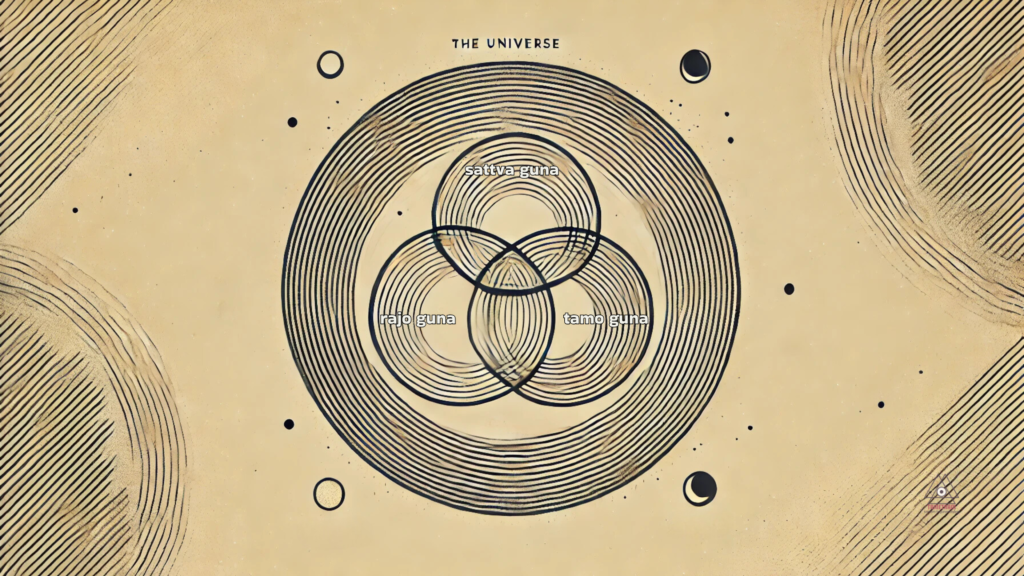
The Universe: A Perfect Blend of the Trigunas (अन्तः अस्ति प्रारम्भः)
The Universe is a perfect blend of the Trigunas. It balances the three Gunas perfectly; otherwise, it may culminate in chaos, potentially leading to another Big Bang. If one Guna dominates the others, it results in destruction.
For example, if Tamo Guna dominates, there will be ignorance and inertia, leading to a breakdown of society as people destroy one another. If Rajo Guna dominates, excessive activity and uncontrolled ambition will prevail, causing people to harm each other in their quest for dominance. On the other hand, if Sattva Guna dominates, while it may bring harmony and peace, it could also lead to a stagnant and lethargic existence, where people lose purpose and motivation due to a lack of challenges.This is why a perfect blend of these Trigunas is essential. The same principle applies to the cosmic world as well. Without this delicate balance, the universe as we know it would cease to exist, potentially leading to another Big Bang.
As the Sanskrit saying goes, अन्तः अस्ति प्रारम्भः (Antaha Asthi Prarambhaha)—“The end is the new beginning.”

The Divine Trigunas: Brahma, Vishnu, and Maheswara (सर्वं लयं प्रवहति न स्थिरं जगत्।)
In Hindu philosophy, the Trigunas in their divine aspects are represented by Brahma, Vishnu, and Maheswara.
- Rajo guna is represented by Lord Brahma, the creator, who brings the entire cosmos into existence.
- Sattva guna is represented by Lord Vishnu, the preserver, who sustains nature and maintains balance in the cosmos.
- Tamo guna is represented by Lord Maheswara, the destroyer, who eliminates negativity and facilitates transformation for a new beginning.
Together, these three divine deities symbolize the Trigunas and the eternal cycle of creation, preservation, and destruction. The entire cosmos is a Laya—a continuous, dynamic flow—ever-changing and never static.
As the Sanskrit saying goes, सर्वं लयं प्रवहति न स्थिरं जगत्। (Sarvam Layam Pravahati Na Sthiram Jagat) means “Everything flows in dissolution; the world is never static.”
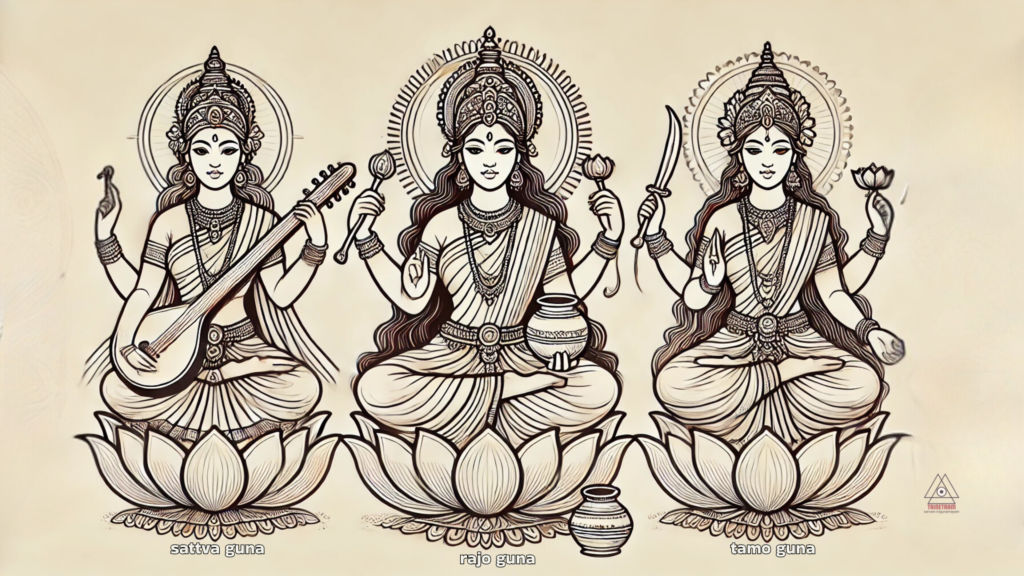
The Divine Feminine Trigunas: Saraswati, Lakshmi, and Parvati (सती लक्ष्मी सरस्वती पार्वती च त्रिगुणात्मकं जगदाधारम्।)
In Hindu philosophy, the Trigunas are also beautifully represented in their divine feminine aspects through the goddesses Saraswati, Lakshmi, and Parvati:
- Rajo guna is represented by Goddess Lakshmi, the goddess of wealth and prosperity, who inspires activity and dynamic energy.
- Sattva guna is represented by Goddess Saraswati, the goddess of wisdom and knowledge, who leads towards clarity and enlightenment.
- Tamo guna is represented by Goddess Parvati, the goddess of transformation and protection, who brings the power to eliminate negativity and pave the way for renewal.
Together, these divine feminine energies represent the balance and interplay of the Trigunas, embodying creation, preservation, and transformation.
As the Sanskrit saying goes, सती लक्ष्मी सरस्वती पार्वती च त्रिगुणात्मकं जगदाधारम्। (Satī Lakṣmī Sarasvatī Pārvatī ca Triguṇātmakaṃ Jagadādhāram.) Means “Lakshmi, Saraswati, and Parvati embody the Trigunas and form the foundation of the universe.”
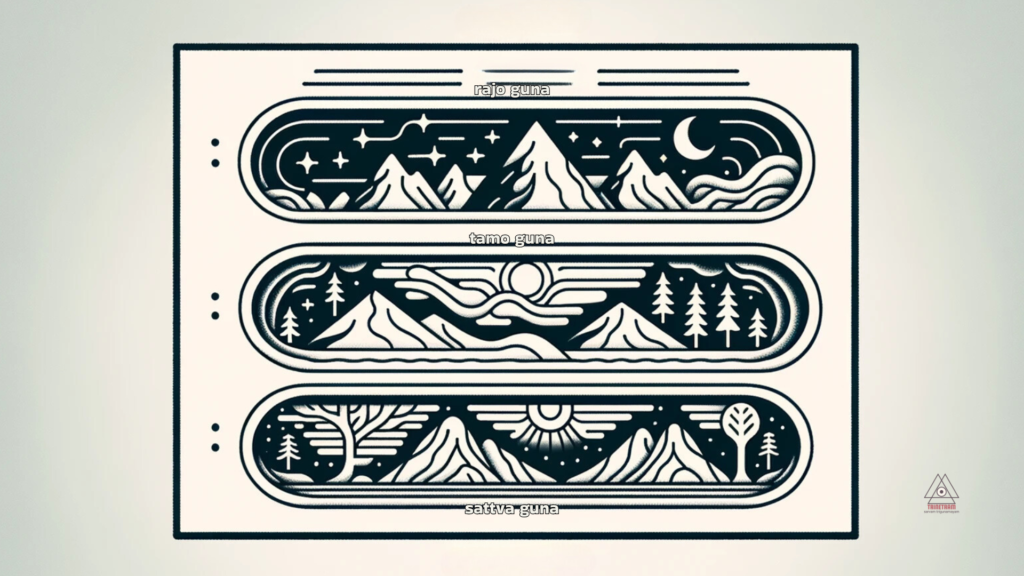
The Trigunas associated with the Trilokas (त्रिलोका त्रिगुणसंयुक्ता जीवनस्य संतुलनं धारयन्ति।)
In ancient Hindu philosophy, the Trigunas are closely associated with the Trilokas—Heaven (Swarga Loka), the Underground (Pataal Loka), and Earth (Bhuloka):
- Sattva Guna represents Heaven (Swarga Loka), symbolizing balance, purity, and harmony.
- Rajo guna represents the Underground (Pataal Loka), embodying active and dynamic energy.
- Tamo guna represents Earth (Bhuloka), functioning as the neutralizing and grounding force.
To maintain harmony and sustain life on Earth, these three Lokas and their corresponding Trigunas must remain in balance. Disruption of this equilibrium could lead to chaos and the destruction of life.
As the Sanskrit saying goes, त्रिलोका त्रिगुणसंयुक्ता जीवनस्य संतुलनं धारयन्ति। (Trilokā Triguṇa Saṃyuktā Jīvanasya Saṃtulanaṃ Dhārayanti.) means: “The Trilokas, united with the Trigunas, uphold the balance of life.”
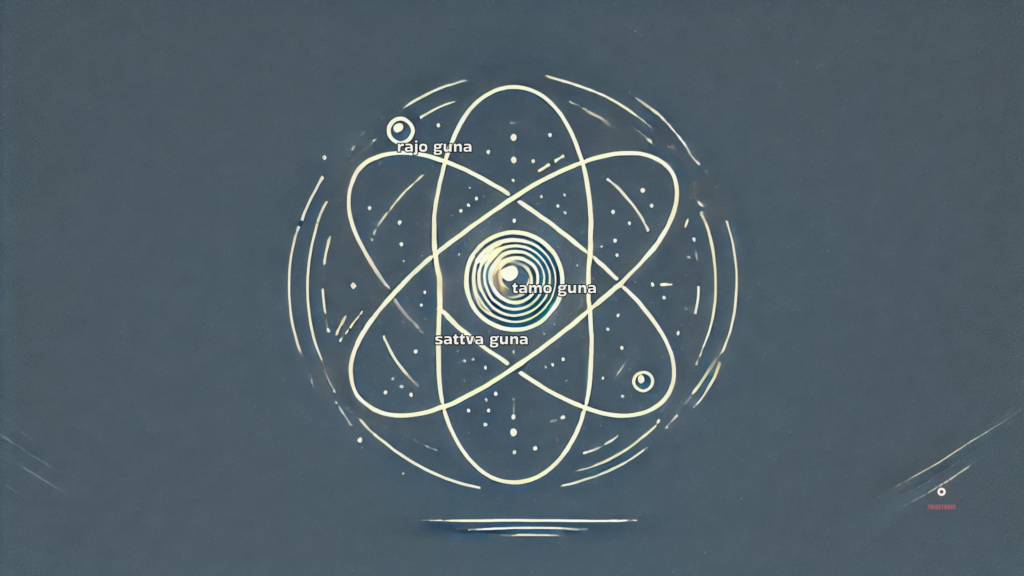
The Atomic Trigunas: Electron, Proton, and Neutron (सत्त्वं रजस्तमः कणाणां मूलं जगद्व्यवस्थितिः।)
In the microcosmic world, the Trigunas are symbolically represented by the electron, proton, and neutron:
- Sattva guna is represented by the Proton, with its positive charge, acting as a stabilizing force.
- Rajo guna is represented by the Electron, with its negative charge, constantly in motion, radiating dynamic energy.
- Tamo guna is represented by the Neutron, with its neutral charge, maintaining balance by counteracting the positive and negative charges.
The combination of these three particles forms the foundation of matter that is Atom, illustrating how even the smallest building blocks of existence are governed by the universal law of Trigunas.
As the Sanskrit saying goes, सत्त्वं रजस्तमः कणाणां मूलं जगद्व्यवस्थितिः। (Sattvaṃ Rajas Tamaḥ Kaṇāṇāṃ Mūlaṃ Jagadvyavasthitiḥ.) Means “Sattva, Rajas, and Tamas are the essence of particles, forming the foundation of the world’s existence.”
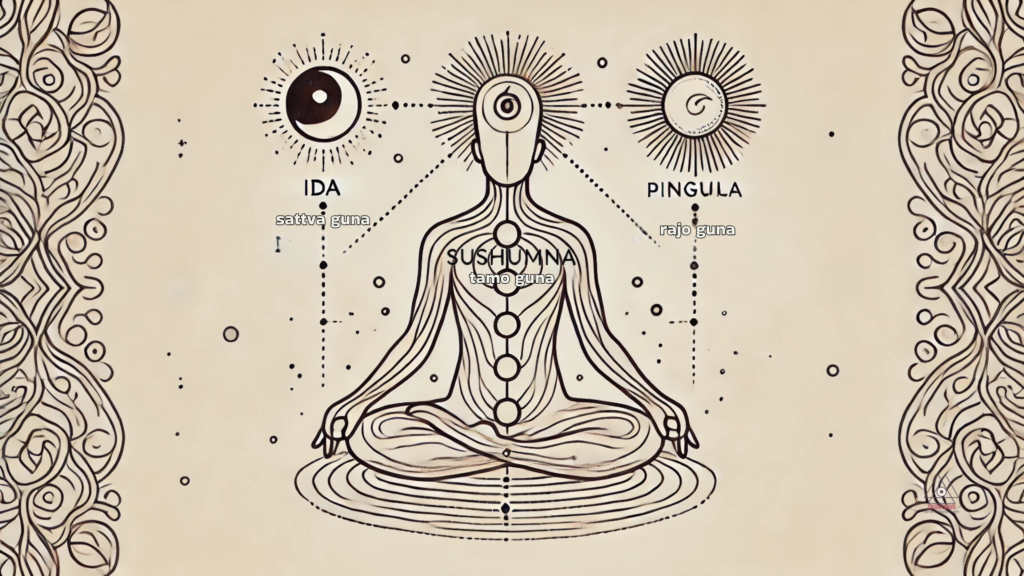
The Human Trigunas: Ida, Pingala, and Sushumna (इडा पिङ्गला सुषुम्णा च त्रिगुणात्मकं शरीरं नयन्ति।)
In yogic literature, the human body is seen as a microcosm of the entire universe. The Trigunas within our body are represented by the three primary Nadis: Ida, Pingala, and Sushumna.
According to various texts:
- The Shiva Samhita mentions that the body contains 350,000 Nadis.
- The Prapancha Tantrasara describes 300,000 Nadis.
- The Bhuta Shuddhi Tantra describes 72,000 Nadis.
Among these, the three most significant Nadis are Ida, Pingala, and Sushumna:
- Sattva guna is represented by the Ida Nadi, associated with the moon and calmness, promoting harmony and clarity.
- Rajo guna is represented by the Pingala Nadi, associated with the sun and activity, driving energy and dynamism.
- Tamo guna is represented by the Sushumna Nadi, serving as the neutralizing force, balancing the energies of Ida and Pingala.
Thus, our body and mind are governed by these three Nadis, and in turn, by the Trigunas, reflecting the universal principles of balance and harmony within us.
As the Sanskrit saying goes, इडा पिङ्गला सुषुम्णा च त्रिगुणात्मकं शरीरं नयन्ति।(Iḍā Piṅgalā Suṣumṇā ca Triguṇātmakaṃ Śarīraṃ Nayanti) means “Ida, Pingala, and Sushumna governing the body and mind, embodying the Trigunas.”
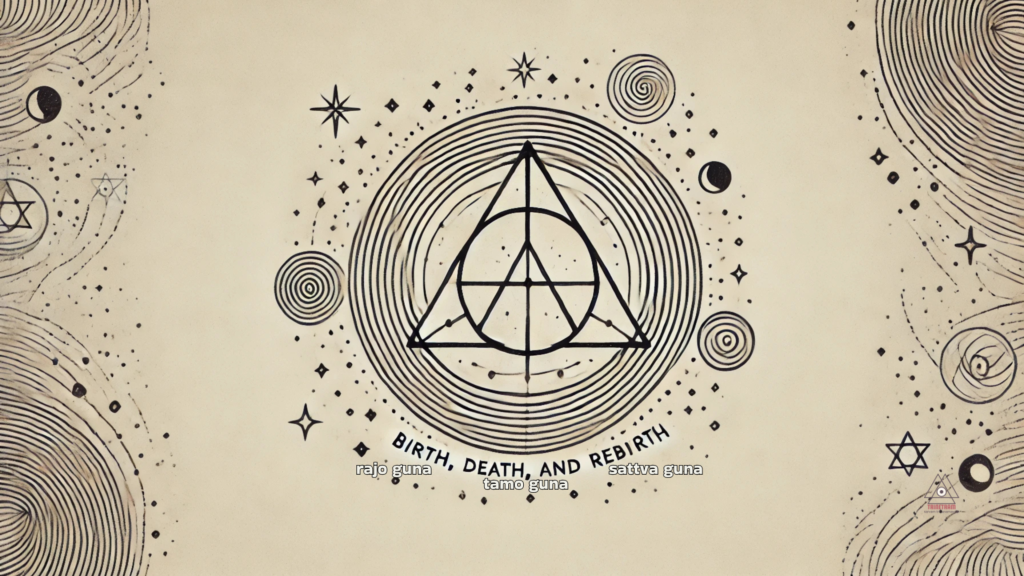
The Trigunas in life Cycles: Birth, Life and Death (जन्म जीवनं मृत्युः च त्रिगुणानां चक्रं धारयति।)
The Trigunas are intrinsically connected to the life cycle, correlating with birth, life, and death:
- Sattva Guna represents Life, symbolizing harmonious balance and preservation.
- Rajo guna represents Birth, embodying the creative and dynamic energy of beginnings.
- Tamo guna represents Death, serving as a transformative force that clears the way for renewal and rebirth.
Thus, the Trigunas play a vital role in sustaining the cycle of life, ensuring the continuity of existence through birth, death, and rebirth.
As the Sanskrit saying goes, जन्म जीवनं मृत्युः च त्रिगुणानां चक्रं धारयति।(Janma Jīvanaṃ Mṛtyuḥ ca Triguṇānāṃ Cakraṃ Dhārayati.) means: “Birth, life, and death uphold the cycle of the Trigunas.”
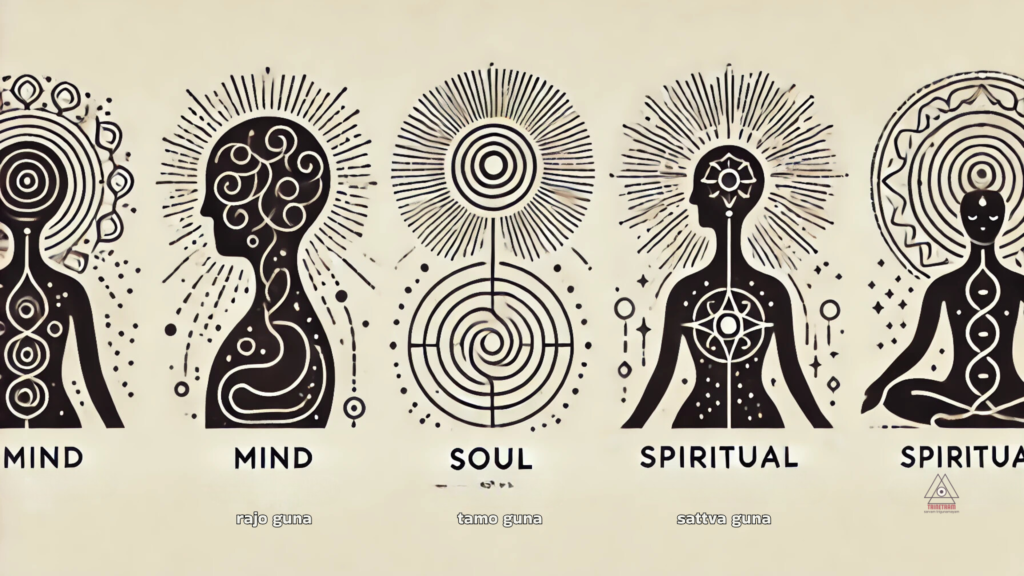
The Trigunas associated with the Tripuras (त्रिपुराणां त्रिगुणयोगः शरीरस्य संतुलनं धारयति।)
In ancient Hindu philosophy, the Trigunas are symbolically connected to the Tripuras—three aspects of existence that represent the Human body, those are mind, and soul, or material, subtle, and spiritual domains:
- Sattva Guna is associated with the spiritual domain that is Para-pura, representing the highest spiritual domain and ultimate truth, symbolizing purity, balance, and enlightenment.
- Rajo Guna is associated with the subtle domain that is Madhya-pura, the realm of the mind and subtle energies, embodying activity, passion, and dynamism.
- Tamo Guna is associated with the material domain that is Adho-pura, the material domain of the body, representing inertia, ignorance, and transformation.
Thus, the harmonious balance of the Tripuras, aligned with the Trigunas, allows the human body to function in a balanced and harmonious way. Any disruption in this delicate equilibrium of the Tripuras can destabilize the body, leading to physical, mental, or spiritual disturbances.
As the Sanskrit saying goes,. त्रिपुराणां त्रिगुणयोगः शरीरस्य संतुलनं धारयति। (Tripurāṇāṃ Triguṇa-Yogaḥ Śarīrasya Saṃtulanaṃ Dhārayati.) means “The union of the Tripuras with the Trigunas upholds the balance of the body.”
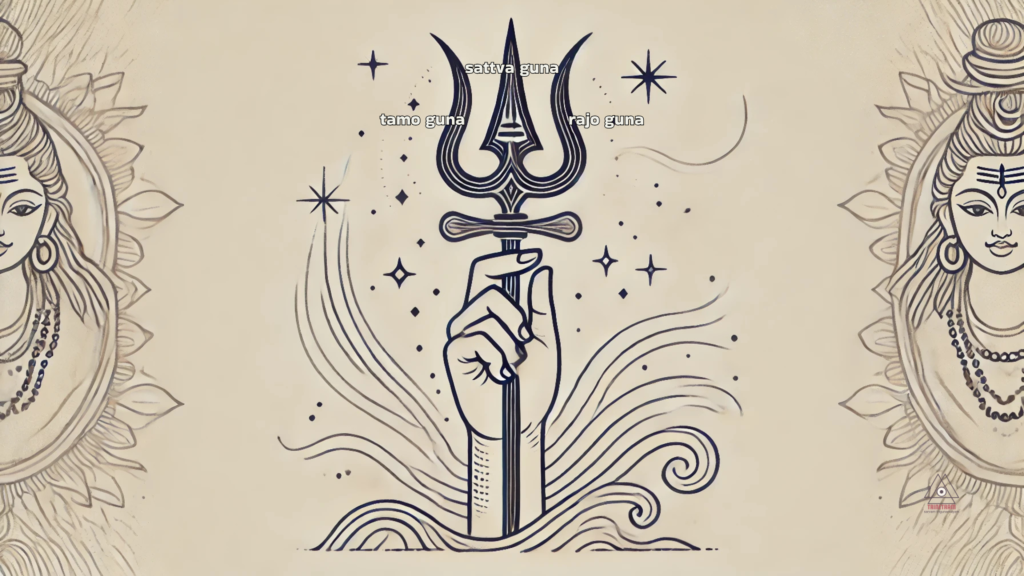
Trigunas associated with Trishula (Trident) त्रिशूलेन त्रिगुणानां संतुलनं जीवनस्य विजयः।
The Trishula, or trident, held by Lord Shiva, is a powerful symbol of the Trigunas. The three prongs represent Sattva guna, Raja guna, and Tamo guna, and the trident’s shaft signifies the unity of these forces. Shiva’s use of the trident reminds us that balance among the Trigunas is the key to mastery over life.
As the Sanskrit saying goes, त्रिशूलेन त्रिगुणानां संतुलनं जीवनस्य विजयः।(Triśūlena Triguṇānāṃ Saṃtulanaṃ Jīvanasya Vijayaḥ.) means “With the Trishula, the balance of the Trigunas leads to mastery over life.”
Mastering the Trigunas in Daily Life (त्रिगुणानां वैराग्यम् संतुलनं जीवनस्य सिद्धिः।)
To achieve balance in life, one must master the Trigunas.
- Master Sattva Guna through meditation and yoga to cultivate clarity and harmony.
- Master Rajo Guna by channeling its energy into productive and creative pursuits.
- Master Tamo Guna through good sleep and quality rest to restore and rejuvenate.
However, do not allow any one Guna to dominate or prioritize it over the other two, as this will disrupt the balance of your life. Strive for control over all three Trigunas to lead a victorious, peaceful, and harmonious life.
As the Sanskrit saying goes त्रिगुणानां वैराग्यम् संतुलनं जीवनस्य सिद्धिः। (Triguṇānāṃ Vairāgyam Saṃtulanaṃ Jīvanasya Siddhiḥ.) means “Mastery and balance of the Trigunas is the key to the fulfillment of life.”
Conclusion
The Trigunas are not just an ancient concept; they can be observed and felt everywhere—whether in living or non-living things, at the microcosmic or macrocosmic level. They manifest in your actions, your thoughts, your mind, and all around you. By mastering and balancing these Trigunas, you unlock the potential to create miracles in your life and transform yourself into a higher being, operating at a higher dimensional level. Such is the profound power of the Trigunas. We will delve into each of the Trigunas in our upcoming blogs. Until then, stay tuned to trinetramyc.com! 🌈
We would love to hear your valuable thoughts and insights to help us deepen this exploration.
Thank you,Team Trinetram 🙏
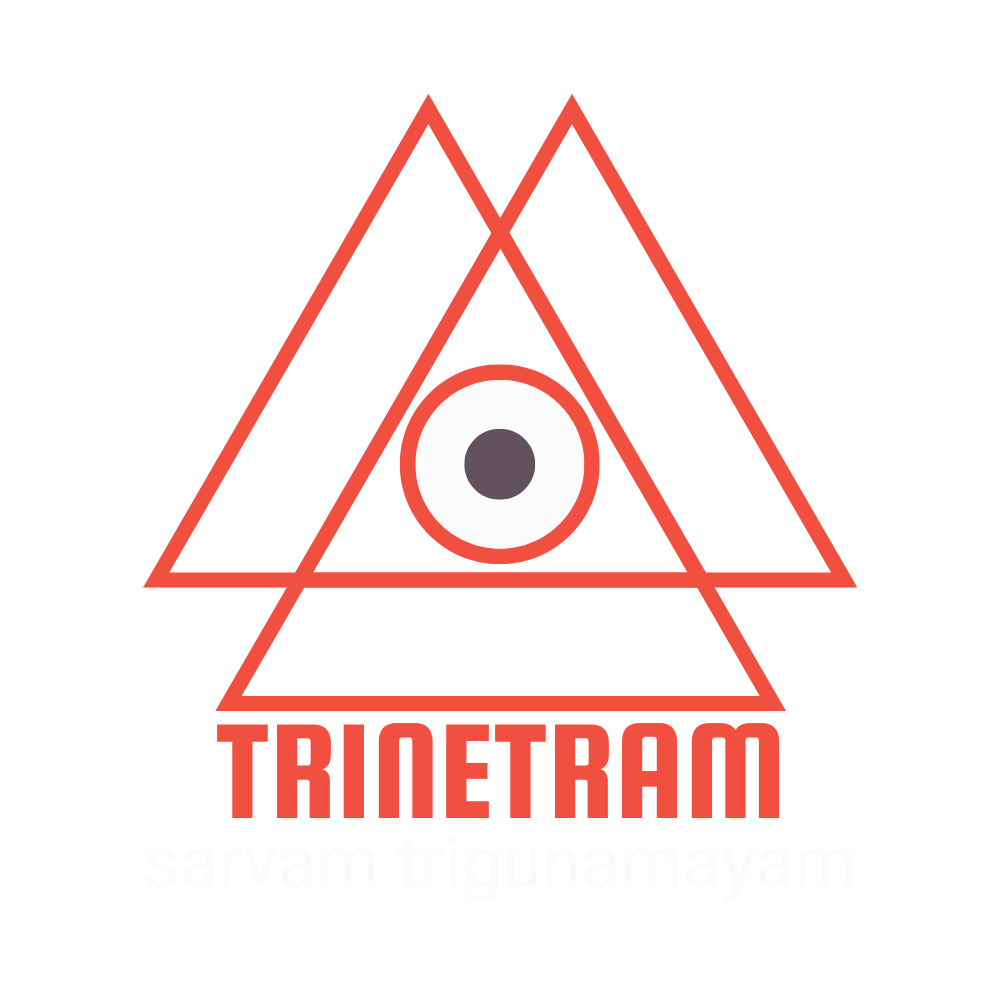
Leave a Reply